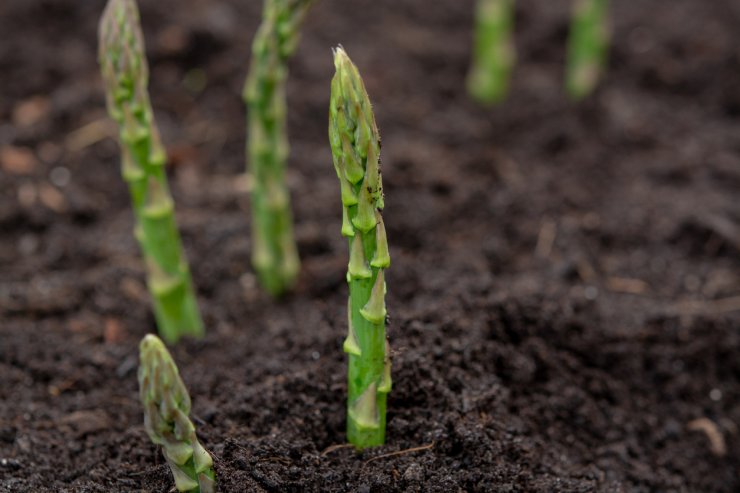If you’re looking for a return on your gardening investment, it doesn’t get much better than asparagus. Plant this vegetable one time and you could find yourself harvesting asparagus for up to 30 years!
Before we get too far, though, let’s address the big hesitation about growing asparagus. A lot of people believe asparagus is difficult to grow. If you don’t have patience, this is absolutely true. The root system needs two to three years of growth to establish itself before you can begin harvesting asparagus.
Those limitations didn’t stop Louis XIV from deeming asparagus “the king of vegetables.” Nor should it prevent you from enjoying all that asparagus has to offer as a garden vegetable.
Asparagus is one of the first plants to pop up in spring. It’s a sign of all the wonderful vegetables that will soon be thriving in your garden. And it’s a beautiful plant. Bright green or purple spears standing straight and tall are a visual feast.
Add to that how easy it is to cook this vegetable – simply grilled with a dash of olive oil, salt, and pepper – and you have an unquestioned winner. So let’s talk about growing this gorgeous plant.

Your quick guide to growing asparagus
Asparagus is easy to plant and grow, but because this vegetable is a perennial, it has some special requirements for planting. Your crop will keep producing for decades, so be sure to give your asparagus garden plenty of space as they will spread and create new shoots each year.
Similarly, sun-loving asparagus plants can grow up to 6 feet tall, so be sure to plant them where they won’t shade your other sun lovers.
Asparagus is a slow-growing plant —so, starting from seed will add a year to the amount of time you’ll have to wait for a harvest. If you start with a crown, ensure you have a weed-free bed amended with plenty of compost.
- As the young shoots (spears) appear, add more soil to the trench, avoiding covering the foliage.
- Repeat adding soil to the trench 2 or 3 more times as the shoots grow until they are 10 to 12 inches high. The trench should be full by the end of the growing season.
- Water weekly until the soil is moistened 8 to 12 inches deep. And keep weeding!
- In the late fall, after the foliage has died back and turned brown or yellow, cut the foliage back to 2 inches and apply mulch around the plant to keep the roots warm during the winter.
- In the spring, check your asparagus beds. Cut off the old tops before new shoots start to appear.
That gives you a general overview of planting and growing asparagus, but be sure to read the entire Asparagus Gardening Guide to get the full rundown on details like soil, water, and fertilization needs. Plus, you can learn the secret to growing white asparagus. Of course, if you’re growing asparagus, you’ll want to enjoy it, right? So let’s move on to getting this vegetable on our plates!
The joy of harvesting asparagus
This is where your patience pays off. And it’s absolutely worth the wait the day you bite into a tender asparagus spear that comes straight from your own garden. After two or three years of staring longingly at your plant and giving it time to establish roots, you can begin harvesting asparagus. It’s quite an easy process, but there are a few things to consider.
Depending on how established your plant is, you can harvest asparagus for a couple of weeks up to a couple of months. And though asparagus is slow-growing initially, the spears come up pretty quickly.
You could have new spears ready to harvest every couple of days, so be sure to check often. If they get too large or begin to open, they won’t be edible.
There’s also some personal preference involved, so feel free to experiment, but for the most part:
- Harvesting asparagus spears when they’re in the 5 to 7-inch range will give you nice, tender vegetables.
- Harvest before any flower buds open, or they will become bitter.
- To harvest them, simply snap or cut them with clean shears or a sharp knife at ground level.
- Trim, wash and cook only until gently tender. Over-cooked asparagus will be tough and stringy.
- Or, store in the refrigerator upright in a mason jar or clean flower vase with an inch or two of water, and covered with a plastic bag or wrap to keep fresh.
When you get toward the end of the season, there’s something important to remember. Do not harvest and eat every single spear! I know they’re good. But leave several spears growing throughout the season to help keep the plant in good shape. Then in early winter, you can cut them back.
In the meantime, enjoy some Asparagus and Goat Cheese Bruschetta at your next barbecue. Or try the delightful and comforting Cream of Asparagus Soup.
You can get these recipes, along with several more delicious and easy recipes highlighting asparagus in the Asparagus Gardening Guide. Discover the history of this beloved vegetable, learn about some of the popular varieties, and find out why purple asparagus is good for your heart. With Asparagus–King of the Garden, you can find out all about growing, harvesting, cooking, and eating this wonderful vegetable.


 Previous
Previous

